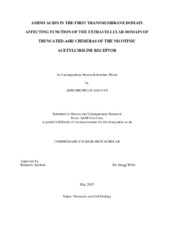| dc.description.abstract | Important neurological and psychiatric diseases, including Alzheimer disease, nicotine addiction, and schizophrenia, are influenced by nicotinic acetylcholine receptors (nAChRs). Understanding the structure and function of nAChRs will provide a foundation for developing drug therapies for these diseases. nAChRs are members of the Cys-loop receptor superfamily. Each nAChR contains five subunits with each subunit containing four transmembrane domains. Once the ligand binds to the extracellular domain (ECD), the section of the nAChR that is exposed to the external environment, the protein undergoes a conformation change and an ion flux occurs allowing signal transmission. The first transmembrane domain (M1) is specifically critical for the function of the neurotransmitter-binding ECD in nAChRs. The features of M1 that are essential for ECD function, however, are not fully known. M1 sequences from ionotropic serotonin (5HT3A) and from α4, β2, and α7 nAChR subunits are similar but behave differently in ECD α4β2 nAChRs. The sequence differences provide the opportunity to discover amino acids from M1 that promote or inhibit ECD function. Through site-directed mutagenesis and expression of chimeric M1 domains with extracellular α4 and β2 subunits in Xenopus oocytes, we determined amino acids in native M1 controlling expression of ECD α4β2 nAChRs and amino acids from the 5HT3A M1 inhibiting that expression. Generating a feasible ECD will provide insight into the essential properties allowing proper ligand binding, conformational changes, and in result the ion cascade triggering the receptor’s function. The truncated designs of full length receptors will contribute to understanding how nAChR subunits fold and assemble and how their transmembrane domains affect structure and function. The results will aid in identifying the importance of M1 in ECD function and guide the development of ECD Cys-loop receptors as water-soluble structural models of the full length receptors. Water-soluble models are a key step in advancing our understanding of nAChRs due to the difficulty of producing high resolution structural models of full-length nAChR through crystallography. With the advantageous physical properties of water-soluble protein, the shortcomings of crystallography with the full-length nAChRs would be overcome, allowing for further understanding of nAChR assembly, function, and future drug design. | en |


